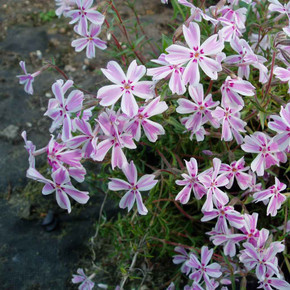
Phlox subulata 'Emerald Cushion Blue' - MOSS PHLOX 'EMERALD CUSHION BLUE' (vigorous & very spreading)
Phlox subulata 'Emerald's Cushion Blue' is a cultivar with large, pale lilac-blue flowers. This is a very vigorous variety, sturdy and robust, with bigger needles. Forms larger-sized mats. Excellent, modest cultivar.
Moss phlox or creeping phlox forms dense, low, evergreen or semi-evergreen mats. In early spring, the flowers completely cover the whole plant. An easy-to-grow and adaptable perennial, the only needs are some sunlight and a measure of drainage is essential!
A favorite plant for rock gardens, xeriscapes, edging, dry slopes, sunny areas of woodland gardens, native plant gardens, naturalizing, and as a substitute for the lawn in sunny, drier soil. Looks very good with rock. Although this is considered to be a "ground covering" plant, it's not highly competitive - it can compete only in sunny and dry spots (other plants can quite easily self-seed, intermingle or even overpower it).
Blooming Time: usually for a couple weeks in April/May
Size: 4” tall x 3' wide
USDA Zones: 3 to 9
Culture: full sun, half shade, dappled sun; organic, gravelly, rocky, sandy, poor, and shallow soils
Moisture Needs: dry, medium-dry (soil has to be drained)
Origin: the wild form of Phlox subulata is a native wildflower to states from Michigan, Ontario, and New York, south to Tennessee and mainly in the Appalachians to North Carolina (see USDA distribution map); often found on dry, rocky or sandy places, open woodland areas, limestone barrens and slopes.
Deer/Rabbit Resistant: yes / yes
Attracts Butterflies or Pollinators: yes / yes - butterflies, skippers, and long-tongued bees; small bugs can feed on leaves
Attracts Hummingbirds: no
Pot Size: square 3.5" x 4" deep perennial pot (1.22 pt/580 ml)
Plant combinations : For the edges, along patios and paths, rock gardens, trough gardens, crevice gardens, slopes. Best combined with smaller to medium sized perennial – from native choose shorter Agastache, Anemone patens, Antennaria, Asclepias tuberosa, dwarf Baptisia, Campanula rotundifolia, Coreopsis, Cunila origanoides, Dalea, shorter Echinacea, Gaillardia, Gaura (shorter cultivars), smaller cultivars of Heuchera (in cooler regions), Penstemons, Ruellia humilis, shorter cultivars of Stokesia, Verbena canadensis, native grasses like Boutelloa gracilis, Koeleria cristata, Sporobolus heterolepis 'Tara' (or non-native Sesleria).
And non-native perennials like Achillea, summer blooming Allium, shorter Aquilegia, Armeria, Calamintha, Campanula, Cerastium, Delosperma, Dianthus, Geranium (G. sanquineum, G. dalmaticum and x cantabrigiense, G. cinereum, G. endresii, G. renardii), Gypsohila, Iris (dwarf and miniature bearded Iris), shorter Lavandula, shorter Nepeta, Origanum, shorter Platycodon, Satureja, Salvia, Sedum, Sempervivum, low Stachys,Scabiosa columbaria, Thymus, lower Veronica and many spring bulbs.
Picture Copyright: US Perennials, LLC

Phlox subulata 'Emerald Cushion Blue' - MOSS PHLOX 'EMERALD CUSHION BLUE' (vigorous & very spreading)
Phlox subulata 'Emerald's Cushion Blue' is a cultivar with large, pale lilac-blue flowers. This is a very vigorous variety, sturdy and robust, with bigger needles. Forms larger-sized mats. Excellent, modest cultivar.
Moss phlox or creeping phlox forms dense, low, evergreen or semi-evergreen mats. In early spring, the flowers completely cover the whole plant. An easy-to-grow and adaptable perennial, the only needs are some sunlight and a measure of drainage is essential!
A favorite plant for rock gardens, xeriscapes, edging, dry slopes, sunny areas of woodland gardens, native plant gardens, naturalizing, and as a substitute for the lawn in sunny, drier soil. Looks very good with rock. Although this is considered to be a "ground covering" plant, it's not highly competitive - it can compete only in sunny and dry spots (other plants can quite easily self-seed, intermingle or even overpower it).
Blooming Time: usually for a couple weeks in April/May
Size: 4” tall x 3' wide
USDA Zones: 3 to 9
Culture: full sun, half shade, dappled sun; organic, gravelly, rocky, sandy, poor, and shallow soils
Moisture Needs: dry, medium-dry (soil has to be drained)
Origin: the wild form of Phlox subulata is a native wildflower to states from Michigan, Ontario, and New York, south to Tennessee and mainly in the Appalachians to North Carolina (see USDA distribution map); often found on dry, rocky or sandy places, open woodland areas, limestone barrens and slopes.
Deer/Rabbit Resistant: yes / yes
Attracts Butterflies or Pollinators: yes / yes - butterflies, skippers, and long-tongued bees; small bugs can feed on leaves
Attracts Hummingbirds: no
Pot Size: square 3.5" x 4" deep perennial pot (1.22 pt/580 ml)
Plant combinations : For the edges, along patios and paths, rock gardens, trough gardens, crevice gardens, slopes. Best combined with smaller to medium sized perennial – from native choose shorter Agastache, Anemone patens, Antennaria, Asclepias tuberosa, dwarf Baptisia, Campanula rotundifolia, Coreopsis, Cunila origanoides, Dalea, shorter Echinacea, Gaillardia, Gaura (shorter cultivars), smaller cultivars of Heuchera (in cooler regions), Penstemons, Ruellia humilis, shorter cultivars of Stokesia, Verbena canadensis, native grasses like Boutelloa gracilis, Koeleria cristata, Sporobolus heterolepis 'Tara' (or non-native Sesleria).
And non-native perennials like Achillea, summer blooming Allium, shorter Aquilegia, Armeria, Calamintha, Campanula, Cerastium, Delosperma, Dianthus, Geranium (G. sanquineum, G. dalmaticum and x cantabrigiense, G. cinereum, G. endresii, G. renardii), Gypsohila, Iris (dwarf and miniature bearded Iris), shorter Lavandula, shorter Nepeta, Origanum, shorter Platycodon, Satureja, Salvia, Sedum, Sempervivum, low Stachys,Scabiosa columbaria, Thymus, lower Veronica and many spring bulbs.
Picture Copyright: US Perennials, LLC
Customer Reviews
-
Moss Phlox
The plant that I received was extremely healthy looking and continues to look well after being in the ground for a week. I am looking forward to the blooms next Spring.
-
Phlox subulata 'Emeral Cushion Blue'
I've reviewed this before. I have 125' of the remains of a concrete wall that is an eyesore that I cannot remove. These hardy plants have dense foliage that will ultimately completely conceal the wall's remains. I love them for this more than the beautiful spring flowers! Super healthy plants.
-
Top quality specimens. well packed!
I was thrilled to find this beloved variety and truly impressed with the quality of the plants I received.






